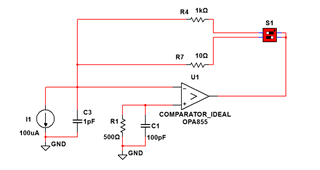Other Parts Discussed in Thread: OPA855, OPA3S2859-EP
Hello, I'm looking for a product, but I can't find a specific model with related functions on the market. Now I will briefly describe it:
As shown in the red circle in the figure below, it can realize the switching of the front-end transimpedance gain of LMH32401; similar to a 1:2/4 mux switch, it can realize the connection between one end (input end) and one of the other end (output end). The signal bandwidth is from DC to AC (it could be 200MHz~500MHz, no strict restrictions). Since the channel realizes the transmission of photocurrent, parameters such as parasitic capacitance and leakage current of the input and output pins need to be considered, and the expected value is <4pF and nA level. Looking for your help here, that you can recommend a specific chip model that can achieve the above-mentioned related functions, or other alternative methods.





